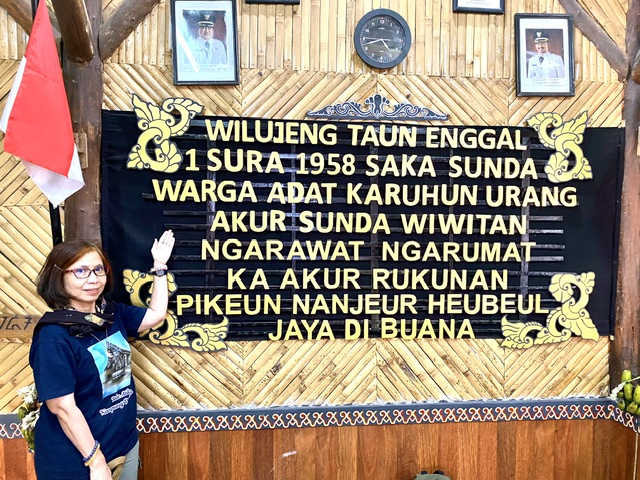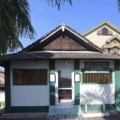Traditional Village of Kampung Pasir
It was not difficult to find the alley leading to the Traditional Village of Kampung Pasir in Cintakarya Village, Samarang District, Garut Regency, West Java, when I visited for the second time. The sign was visible. At the entrance of the alley, which leads to the main road, Cikamiri Road, there was a penjor hanging, a symbol that a celebration was taking place within the alley. I asked the driver of the car I had rented to stop. Several cars were parked along the side of the road. A man assigned to welcome guests approached the car I was in. “I’m Wahyuni from Jakarta, a guest of Kang Caca,” I introduced myself as I got out of the car. Soon after, Kang Caca—the nickname of Caca Soekarsa—appeared. Greeting me, he immediately helped carry my bag.
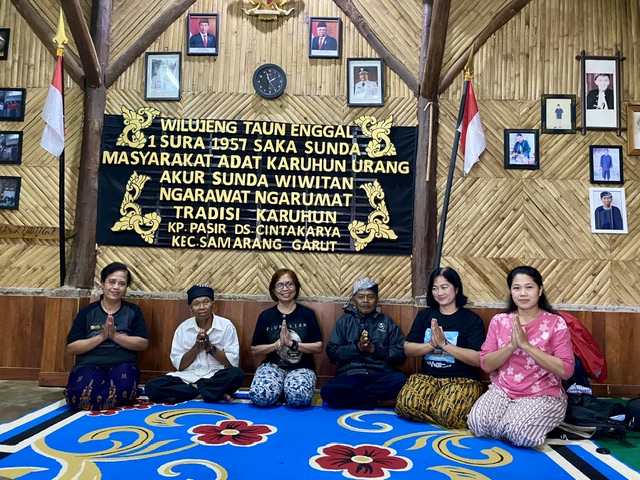
About six months earlier, Kang Caca, 43, had picked me up on a motorcycle from Garut City Station. “I was afraid you might get lost,” was his reason for picking me up. Before that, I had been in communication with Kang Caca, who acts as a public relations representative for the Masyarakat Adat Karuhun Urang (AKUR) Sunda Wiwitan community living in the Traditional Village of Kampung Pasir. At that time, during my visit to the City and Regency of Garut, I specifically stopped by at Kampung Pasir, which is geographically located in Cintakarya Village.
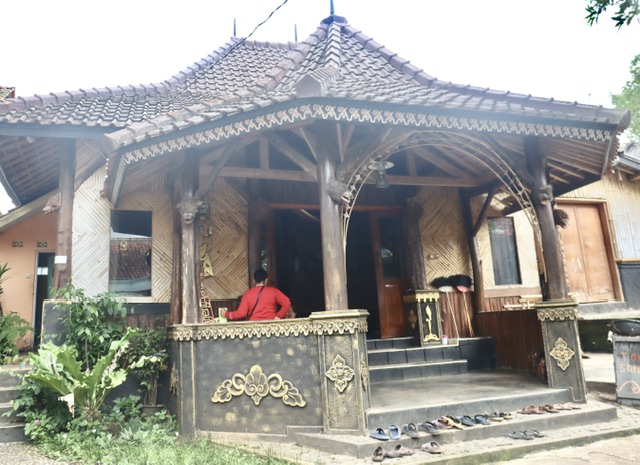
Kampung Pasir is approximately 9 kilometers west of Garut City. When I arrived for the first time, I was immediately taken to Balai Atikan, the main building in that Traditional Village. I was greeted by Abah Endan, who is the adat leader (pupuhu), and several members of the community. Their welcome was warm and unpretentious for someone visiting their village for the first time.
Most residents of Kampung Pasir adhere to the teachings of Pikukuh Sunda. There are 86 households with 312 people. That was my initial introduction to Kampung Pasir.
1 Sura Saka Sunda New Year
My second visit to Kampung Pasir was to attend the invitation for the 1 Sura Saka Sunda New Year event, sent by Kang Caca. The celebration takes place annually in Kampung Pasir. “The 1 Sura of Saka Sunda celebration is traditionally held after the Seren Taun (rice harvest ritual) in Cigugur, Kuningan, West Java, which falls on the 22nd of the month of Rayagung,” said Abah Endan. The month of Rayagung is the last month in the Sunda (Mataram) calendar.
Sultan Agung, the 3rd King of the Mataram Sultanate, merged the Islamic (Hijri) calendar, which is based on lunar cycles, with the Hindu-Buddhist Saka calendar, which is based on solar cycles. This integration occurred at the time of the Saka Hindu-Buddhist New Year 1555, or 1 Muharram 1043 Hijri, or July 8, 1633 AD. The combined calendar is known as the Sultan Agung Calendar. The initial year of the Sultan Agung Calendar refers to the Saka Hindu-Buddhist year 1555.
From central to eastern Java, the Sultan Agung Calendar is also referred to as the Javanese (Islamic) Calendar, while in western Java, it is called the Sunda Islamic Calendar or Sunda Mataram Calendar. “The Seren Taun uses the Sunda Mataram Calendar, which is luni-solar,” said Nalury, 44, a resident of Bandung, West Java, who has been studying the Sunda Calendar since 2018. “The use of Sunda Mataram Calendar by Sunda Wiwitan community (since it was implemented by Sultan Agung) is to ensure safety,” she added. This is because the implementation of the Sultan Agung Calendar is closely tied to the political condition of the Mataram Kingdom at that time, she explained.
The traditional Sundanese Calendar has three systems of calculation: the Sunda Suryakala Calendar (Saka Sunda), which is based on solar cycles; the Sunda Candrakala Calendar (Caka Sunda), which is based on lunar cycles; and the Sunda Sukrakala Calendar, which is based on star constellations. According to Nalury, the year 1958 in the Sunda Mataram (Sunda Islamic) Calendar is equivalent to the year 1946 in the Sunda Saka Calendar and the year 1961 in the Sunda Caka Calendar. “The beginning of the month in the Sunda Islamic or Sunda Mataram Calendar is called Muharram,” she further explained. Interestingly, the Traditional Village of Kampung Pasir uses Sura as the name for the first month, just like in the Javanese Islamic Calendar.
I arrived a day before the peak of the 1 Sura Saka Sunda celebration. The festive atmosphere and busy preparations were already evident. Penjor were set up at various sites where guests would pass by. I was immediately guided to Balai Atikan, which also serves as a multipurpose space. The performance stage had been set up, complete with decorations of janur (palm leaves) and seats for the audience. The stage was located next to Balai Atikan.
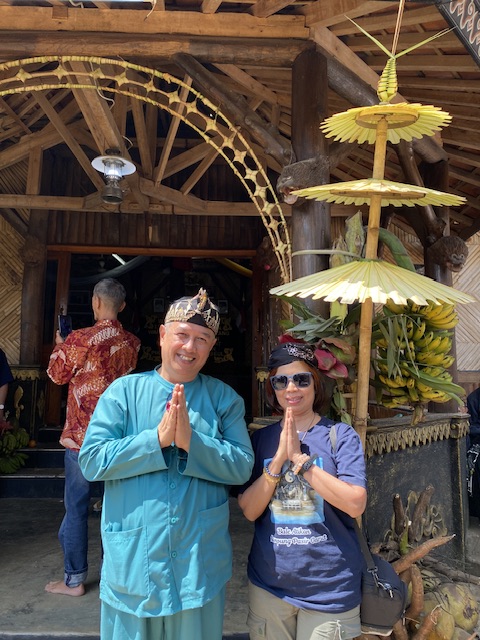
Inside Balai Atikan, Pangeran Gumirat Barna Alam from Cigugur, Kuningan was present. He is the son of Pangeran Djatikusumah—an elder of the Masyarakat Adat Karuhun Urang Sunda Wiwitan in Cigugur. There were also representatives from the Alliance of Indigenous Peoples of the Archipelago. The AKUR Sunda Wiwitan community in the Traditional Village of Kampung Pasir is closely connected with the AKUR Sunda Wiwitan community in Cigugur.
I was immediately invited to take food from a long table that had been set up. Even though I had just eaten, I couldn’t refuse it. Every guest who arrives is usually offered food right away, regardless of whether they have already eaten.
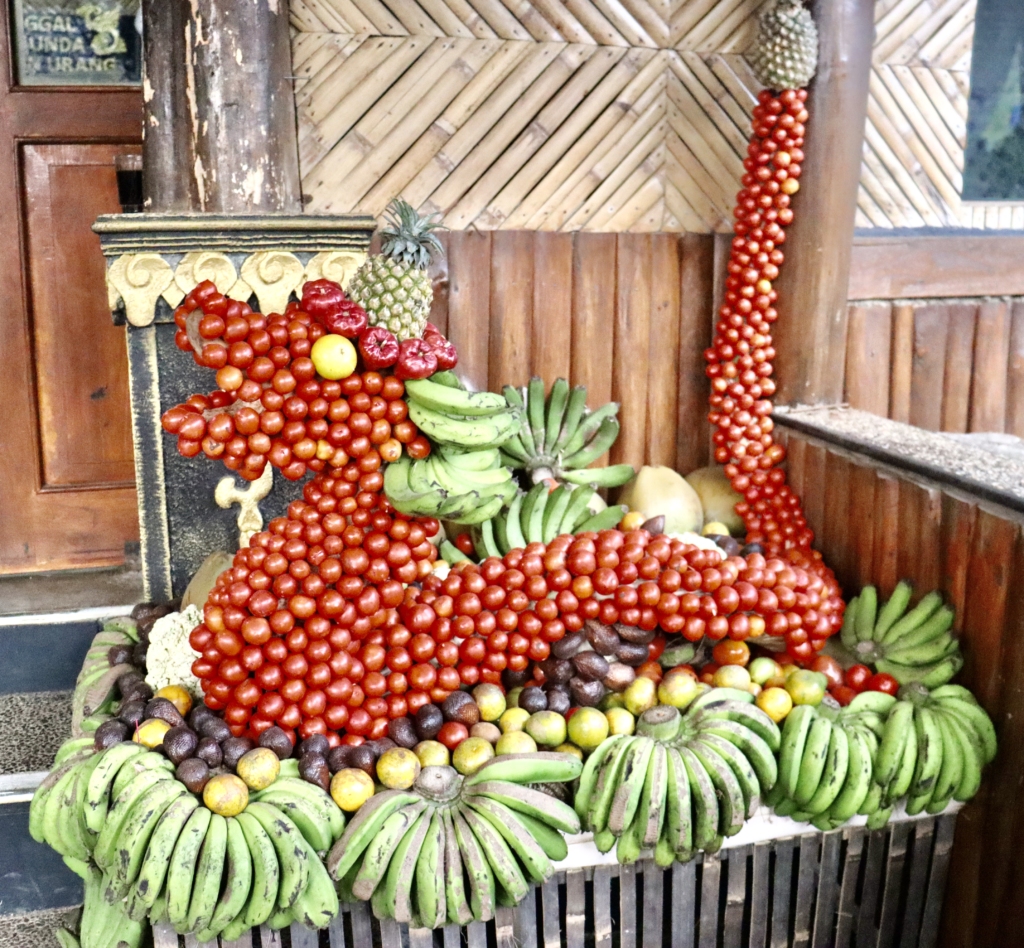
Next, I was invited to watch a performance on the entertainment stage. A banner stretched across the back of the stage, displaying the theme for the Saka Sunda New Year 1958. Each new year, Kampung Pasir has a major theme. This year’s theme is: Ngarawat Ngarumat Ka Akur Rukunan Pikeun Nanjeur Hebeul Jaya Dibuana. According to Abah Endan, this can be summarized: Preserving what has become a tradition from our ancestors, as creations of God, we must help one another, remain steadfast and upright in our beliefs, and thrive in the world.
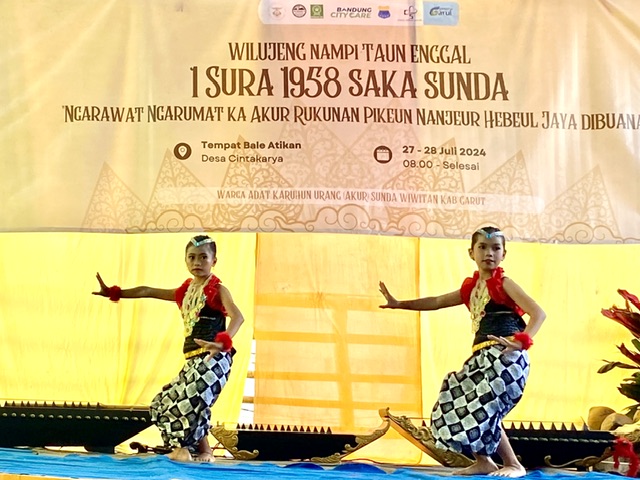
Joyful Performance
The performances on stage included traditional dances and mixed dances presented by children and teenagers. The children performing appeared completely at ease. “They are trained by our women,” Abah Endan replied when asked who trains them. Besides dancing, the children were also skilled in ngabodor (a type of comedy in stage performances in West Java). Some audience members went up to the stage and gave money as a form of contribution (saweran). The atmosphere became lively and full of laughter.
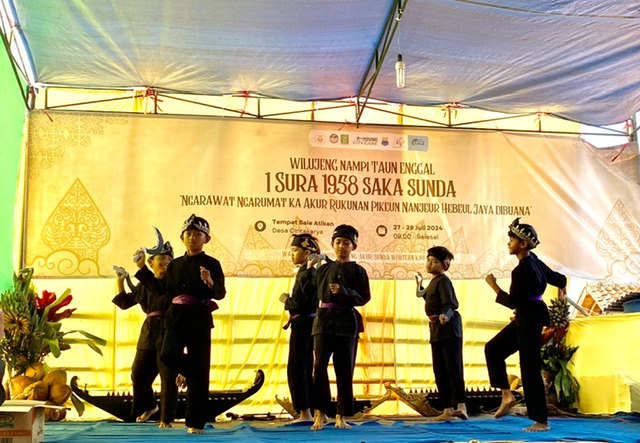
The event as a whole was presented in Sundanese. Although I don’t understand every word, I could catch the meaning bit by bit. Not only the children but also the women performed the modern dance. It was clear that they all enjoyed the excitement. The audience, ranging from children to adults, also got caught up in the festivity.
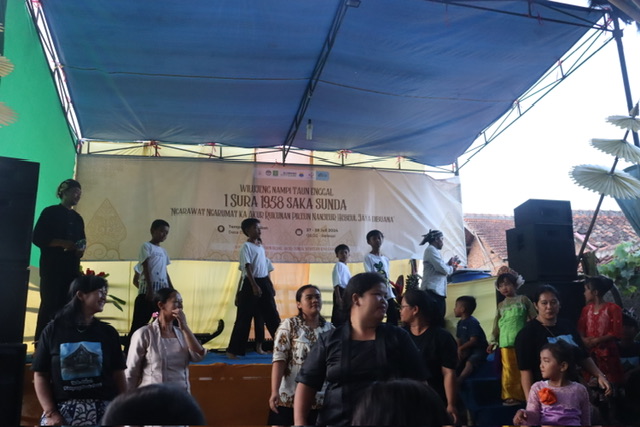
As the Maghrib call to prayer approached, the performance was temporarily halted. The audience and performers dispersed. The call to prayer was heard from the loudspeaker of a mosque in Cintakarya Village. Meanwhile, as dusk fell, some residents of the Kampung Pasir entered Balai Atikan to perform a ritual led by Abah Endan, and to receive lectures from Pangeran Gumirat Barna Alam.
After joining in the ritual, I was escorted to the home of Mrs. Yani, where I would be spending the night. She is a member of the cooking team. Coincidentally, the communal kitchen is located next to her house. “I only have this simple house,” said the mother of three modestly as I entered her spacious home.
I was reluctant to accept an offer for dinner since I still felt full. The stage performance continued, but I excused myself to take a rest. I felt tired. I took an early train to Garut City where I had needed to leave for the station very early. The sounds of the audience could be heard from the room where I was staying, but the cool air soon had me falling asleep.
“Gotong Royong”
In the early hours of the morning, I suddenly woke up from a deep sleep. I needed to hurry to the bathroom. At that early hour, from behind the bathroom wall, I could hear women talking as if they were preparing food in the communal kitchen. It felt as though the day had already started. I glanced at my watch; it was only 3 a.m. Then I went back into the bed in the chilly air.
When the sun had risen, the friendly Mrs. Yani served warm drinks at the guest table. She apologized for not being able to attend to me. She admitted she had been busy working in the communal kitchen since the day before. “I haven’t had a chance to sleep, preparing food for the guests,” she said with a smile. However, her expression did not show any signs of exhaustion.
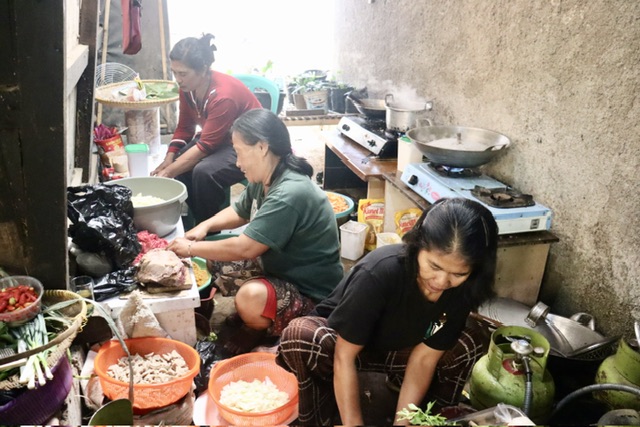
The women in Kampung Pasir were indeed busy during those two days. Each of them had different responsibilities: some were in charge of cooking dishes for the guests in the communal kitchen, some were involved in ceremonies, some handled the performances, and others attended to the guests. The men also had their individual tasks. The preparation appeared harmonious, unburdened, and well-organized.
Ancestral Traditions that Bind Everyone
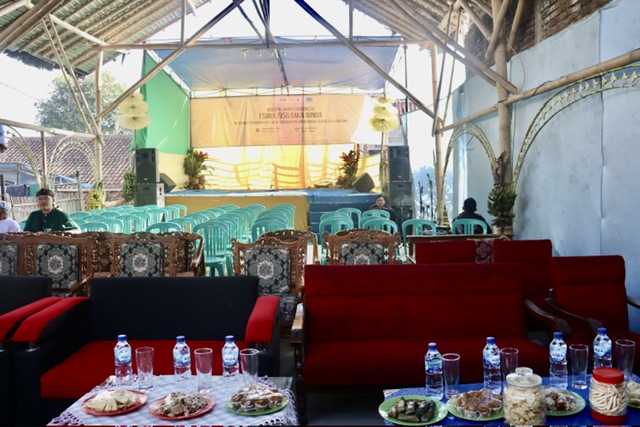
I had arrived at the event venue before it began. Everything was already well set up. The chairs for the guests and the table at the front were neatly set with snacks and cookies in jars. The group that would perform the rajah (melodious poetry) was ready with their musical instruments, and the women performing the hymns were seated in an orderly row with their hair styled and their attire prepared. The leuit (rice barn) was decorated with palm leaves, and the rice that would be part of the ceremony was arranged on the terrace of Balai Atikan. Unlike on the previous day, all the performers and event supporters were wearing white clothing. “White symbolizes purity and cleanliness,” Abah Endan explained. “For those who have white clothes, wear white clothes,” said the man born in 1954. The women involved in the event looked neat and beautiful with their makeup.
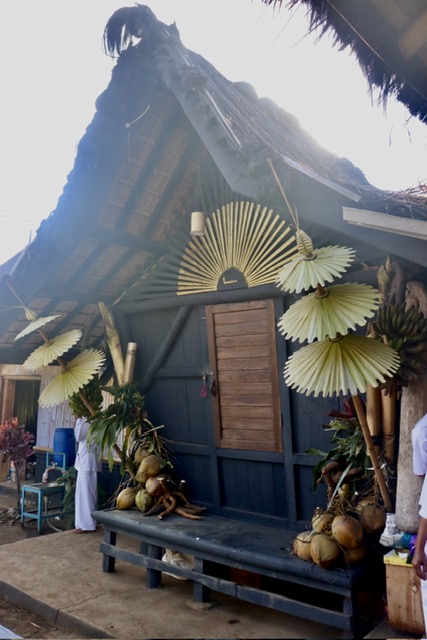
Approaching 8 a.m, the guests began to arrive, including representatives from the Garut District Coordinating Forum, such as the Department of Industry and Trade, the National Unity and Politics Agency, the Department of Tourism and Culture, the Garut Cultural Council, interfaith leaders from Islam, Catholicism, Protestantism, Hinduism, and Buddhism, as well as religious organizations like Fatayat Nahdlatul Ulama and universities that had conducted research there. “300 invitations were sent out, and about 200 came,” said Kang Caca, who handled the invitations.
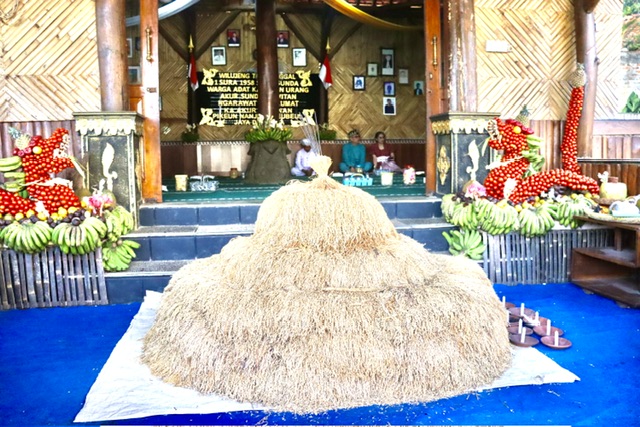
The newly arrived guests were given snacks on small paper plates prepared by the women. The guests took their seats in the provided chairs. The hosts of the event, Abah Endan and Pangeran Gumirat, were already at Balai Atikan.
The event was opened with rajah performed by a group of women, with one leading vocalist singing beautifully and several men accompanying with a bamboo flute and a zither. “The verses contain prayers for safety and happiness,” Abah Endan explained. “These melodic verses come from the Center (Cigugur, Kuningan),” he added. According to Abah Endan, all arts in Kampung Pasir—such as dance, vocal arts, batik, wood carving, and metalwork—are ancestral heritage passed down through generations. They are closely connected to Cigugur, Kuningan, especially batik and angklung buncis.
The performance at the ceremony from the beginning to the end was rich in symbolism, for example, the traditional dance that was performed by four teenage girls wearing sashes (karembong) in four different colors. These four colors symbolize the four cardinal directions and the four elements of nature: air, water, wind, and earth, which are integral to human daily life. In Sundanese Pikukuh teachings, humans are connected with each other, with Nature, and with the Supreme Creator.
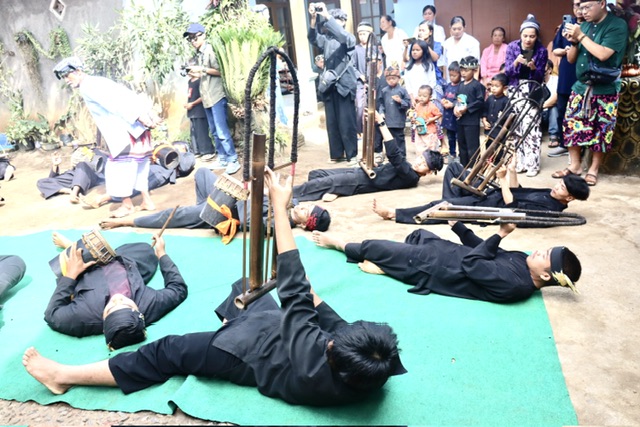
The angklung buncis performance from Cigugur was very fascinating to me. “Buncis is an abbreviation of budaya (culture), urang, nurutkan, cara ciri, insan, sanusantara/Sunda Wiwitan,” said Abah Endan. The buncis angklung is typically performed during harvest celebrations. It is preceded by an elder wearing a traditional headband, who demonstrates a sort of ritual. The performers include angklung players and drummers/percussionists, mostly teenagers. They play the angklung and drums while walking, sitting, and even lying down in a specific formation that has been arranged.
The angklung buncis performance was followed by speeches, all in Sundanese, and interfaith prayers from representatives of the religions present in Bumi Pancasila. The highlight of the event was the traditional ampih pare ceremony.
In the ceremony, there were 11 pairs of men and women dressed in white. They walked together towards Balai Atikan while being accompanied by melodious poetry (rajah). At Balai Atikan, the first pair received a tray containing offerings and a whole coconut. Meanwhile, the next pair—the woman received a tray of rice, and the man received a small clay plate with a lit candle from Pangeran Gumirat. According to Abah Endan, the pairing symbolizes the dualities of life, such as day-night, male-female, and right-wrong. The rice from the Balai Atikan was then taken and stored in the leuit (rice barn). The ceremony was concluded once all the rice had been placed in the barn.
The guests were then invited to sample the delicious food that had been prepared. One of the dishes that might only be served during the ampih pare ceremony is tumpeng bogana. The tumpeng bogana contains chicken as its main dish. This tumpeng is made as an expression of gratitude to the Creator.
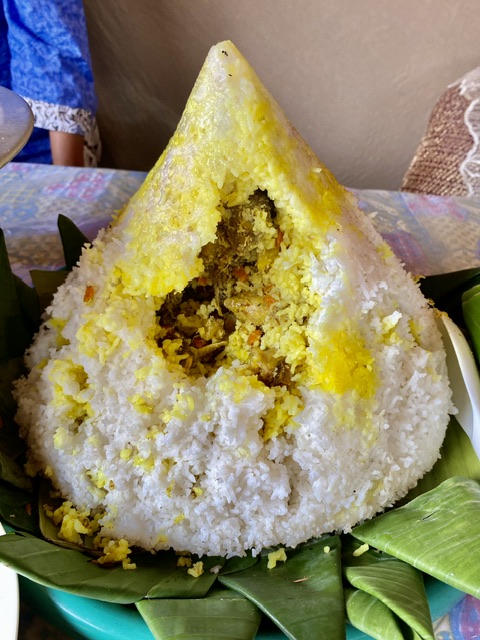
With such a lively event, most of the funding came from the self-help contributions of the community of Kampung Pasir, whose livelihoods include working as seasonal farm laborers, construction workers, or farmers. Additionally, there were also donations from several government departments, the village head, and community organizations.
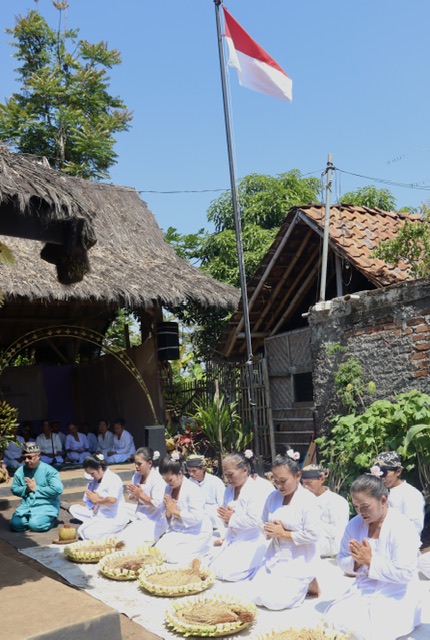
Overall, the 1 Sura Saka Sunda event was conducted with solemnity, a sense of harmony, joy, and, of course, upholding the noble values of Sundanese Pikukuh teachings. The tradition of the AKUR Sunda Wiwitan community in Kampung Pasir for celebrating 1 Sura Saka Sunda has united people from various religions and backgrounds. Their expression of gratitude and thanks to the Almighty, particularly for the rice harvest, is shown by sharing that happiness with others.
This was manifested through entertaining traditional performances on stage, inviting people to witness their ancestral heritage, and, of course, providing meals to the guests. These practices represent local wisdom in the Archipelago that they continuously preserve and uphold. All of this aligns with the theme of the Saka Sunda year 1958: Maintaining and Preserving the Harmony of Ancestral Teachings through Mutual Assistance and Full Faith for the Welfare of the World.
